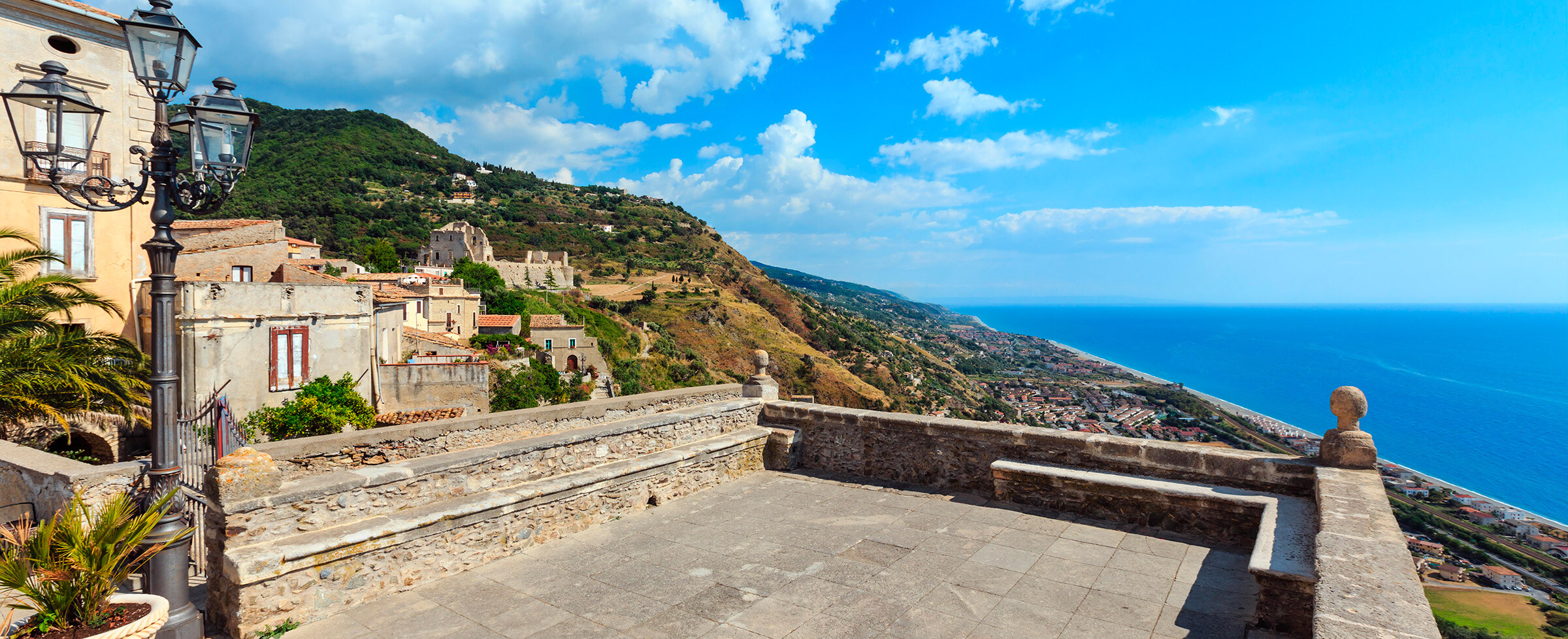If you are on holiday in Southern Italy, we strongly recommend that you visit the West Coast of Calabria, and here we tell you the top things to see.
The story of san Francesco di Paola
San Francesco di Paola is an icon, a symbol, a strong presence in many Calabrian homes.
Visiting the sanctuary, founded by Francis himself in the ‘400, is a ritual for many believers, as well as an evocative mystical and naturalistic path, because you will walk beside natural gratifying landscapes, an oasis of peace.
He is the patron saint of sailors and people living close to the sea. San Francesco di Paola protects all people who have a relationship with the sea.
In the village of Fiumefreddo Bruzio, entranced by art and a splendid view of the Tyrrhenian Sea
A little further, on the south, Fiumefreddo Bruzio is a balcony on the Tyrrhenian Sea.
Memorable view from the halls of the old castle, whose walls were frescoed in the 1900s by Salvatore Fiume, sicilian genius.
His art – whimsical and capricious – has upset the quiet village of medieval origin.
You also absolutely must see the fresco inside st. Rocco’s chapel, a masterpiece inspired by Francisco Goya.
The awesome alleys in Belmonte Calabro
You can not leave this place until you have tasted a salad made with Belmonte Calabro Tomato!! It’s the “agri star” in this amazing land. We suggest a short intensive tour in the fields to know the local farmers.
Then, go and venture into the alleys of the old village.
Guided by Core Calabro experts you can even explore ancient mountain bike trails, descending from 1541 meters of Monte Cocuzzo to the sea.
Amantea, something good about seafood and traditions
Amantea is witness and ambassador of the ancient gastronomic culture on this side of the Tyrrhenian coast. The preserve of anchovies, here, is an excellence.
Amantea is also a trade center for the whole district and a very popular place for seaside tourism.
We recommend a tour in the old quarters, located below the plateau of the old fortifications. They are characterized by civil and religious architectures of exquisite workmanship.
The church and the convent of the Franciscan Minors preserve art treasures.
San Francesco di Paola
The first buildings date back to the 15th century. Francesco was born in Paola on March 27, 1416, and died in Tours, France, on April 2, 1507. This last day is the one chosen by religious calendar, to celebrate him.
The popular and religious celebration in Paola is an event held on May, from 1st to 4th. That’s a traditional custom (even a big local fair) related to the early days of May 1519, when some people broke the news of the canonization of Francis.
This is the Order of Minimi. The friars wear a black hooded robe – called ‘patience’ – under which, if it is cold, they can wear a tunic. The black robe is held in place with a wool cord (belt) of the same color. Some wear a long black cloak on the dress.
Sandals, clogs, footwear must always be open.
Distinguishing features: perpetual Lenten abstinence from meat, milk and their derivatives.
Telephone secretary, information to celebrate Masses: +39 0982 582518
Salvatore Fiume
Born in 1915 in Comiso (Sicilia), he was a volcanic artist and he exhibited all over the world. A color experimenter, he distorted and glorified feminine forms, he created art in unthinkable places, such as the remote rocks in the Babile Valley in Ethiopia.
Among the most valuable international works: the paintings triptych Isola di Statue, today in the Vatican Museums; the painting Città di Statue at the MoMA in New York; the odd thematic series Adventures, misfortunes and glories of ancient Umbria in the Sala Fiume of Palazzo Donini in Perugia.
In Fiumefreddo Bruzio the frescoes of the Stanza dei Desideri at the castle stand out. Tourists appreciate the uniqueness of the sculptures of La Ragazza del Surf in largo Torretta and La Ruota della Fortuna in largo Rupe. It’s really impressive the fresco about San Rocco (that frees from the plague) in the small church dedicated to the saint of MontPellier, paintings that wrap around the inner walls of the dome.
Tomato of Belmonte (Pomodoro di Belmonte)
Cultivation area: hills of Belmonte Calabro. Period: spring-summer.
2 types, known in botanical studies: the one called Cuore di Bue; and the Giant one.
The best dish: salad with Pomodoro di Belmonte (and onions).

